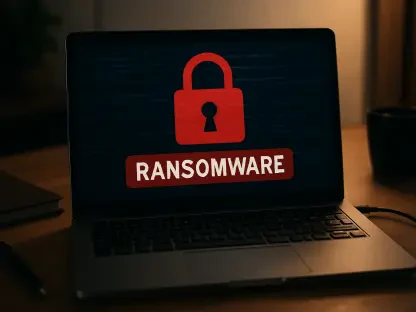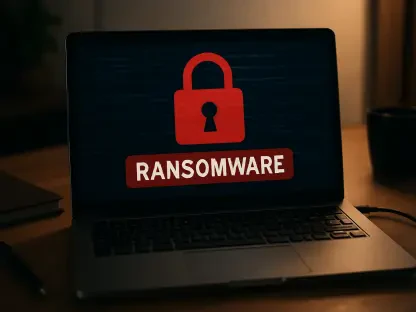What happens when a single click on an innocuous file hands over the keys to an entire digital life? A shadowy Russian hacking group known as EncryptHub, also dubbed LARVA-208 and Water Gamayun, has mastered this terrifying art with chilling precision. By exploiting a critical flaw in Microsoft Windows, they’ve unleashed a stealthy malware called Fickle Stealer, infiltrating systems across the globe. This feature dives into the heart of their sophisticated campaign, exposing the deceptive tactics and technical exploits that have cybersecurity experts on high alert. The stakes couldn’t be higher as businesses and individuals scramble to defend against an invisible enemy that strikes without warning.
Why This Cyber Threat Commands Immediate Focus
EncryptHub isn’t just another hacking collective; they represent a new breed of cybercriminal driven by financial gain and armed with relentless adaptability. Since ramping up operations in recent months, their ability to exploit trusted platforms and critical system vulnerabilities has sent shockwaves through the cybersecurity community. Trustwave SpiderLabs has flagged their high operational tempo as a clear signal that traditional defenses are struggling to keep pace. The urgency to understand and counter their methods has never been more pressing, as every unpatched system or unaware user becomes a potential entry point for devastation.
The scale of the threat is staggering. Reports indicate that EncryptHub’s campaigns target a wide range of victims, from multinational corporations to individual gamers, showing no discrimination in their pursuit of data and profit. Their knack for blending into legitimate digital environments makes them particularly dangerous, as even the most cautious can fall prey to their traps. This isn’t a distant problem—it’s a direct challenge to the security of every connected device, demanding immediate attention and action from all corners of the digital world.
The Intricate Web of EncryptHub’s Deceptions
At the core of EncryptHub’s strategy lies a deadly combination of human manipulation and technical wizardry. Their social engineering tactics are as polished as they are insidious, with attackers posing as IT support staff or dangling fake job offers to lure victims into lowering their guard. Often, they exploit platforms like Microsoft Teams to request remote access or entice users through compromised Steam games, creating a false sense of trust before striking with devastating payloads.
Beyond psychological tricks, EncryptHub capitalizes on a specific vulnerability in the Microsoft Management Console framework, known as the MSC EvilTwin flaw (CVE-2025-26633). By crafting rogue Microsoft Console files—one harmless, one malicious—with identical names, they deceive users into triggering infections with a simple double-click. This technical exploit, now patched, was a gateway for their malware to slip past defenses, showcasing their deep understanding of Windows systems and their ability to weaponize even the smallest oversight.
Their reach extends to abusing legitimate services for malicious ends. Platforms like Brave Support have been hijacked to host harmful content after attackers gained unauthorized access to accounts with upload permissions. Additionally, fake videoconferencing tools like RivaTalk serve as vehicles for distributing MSI installers that sideload malicious DLLs, quietly running PowerShell scripts to harvest data. This multi-pronged approach, blending human error with system flaws, paints a picture of a group that thrives on exploiting every possible weakness.
Inside the Malware Arsenal Fueling the Attack
EncryptHub’s toolkit is as diverse as it is dangerous, with Fickle Stealer leading the charge as a primary weapon for data theft. This malware silently siphons sensitive information from compromised systems, feeding it back to encrypted command-and-control (C2) servers that are nearly impossible to trace. Alongside it, tools like SilentCrystal—a Go-based loader—facilitate the delivery of additional payloads, ensuring the attackers maintain a foothold in targeted environments.
Further deepening their grip, malware variants such as SilentPrism and DarkWisp enable persistence and control, often using encrypted communications to evade detection. Techniques like SOCKS5 proxy tunneling mask their infrastructure, while fake system configuration pop-ups distract users as malicious processes run in the background. These elements highlight a calculated effort to stay hidden, blending their traffic with legitimate activity by mimicking requests to popular websites.
The sophistication doesn’t stop at deployment. EncryptHub continuously refines its arsenal, incorporating Golang-based backdoors to collect system metadata and execute commands with precision. This adaptability, combined with a knack for distraction and stealth, positions their malware as a formidable challenge to even the most advanced security solutions. Each tool serves a distinct purpose, creating a layered attack structure that is as resilient as it is destructive.
Voices from the Frontlines of Cybersecurity
Experts are sounding the alarm on EncryptHub’s relentless ingenuity. Nathaniel Morales and Nikita Kazymirskyi from Trustwave SpiderLabs have described the group as a “formidable adversary,” emphasizing their seamless integration of social engineering with technical exploits like the MSC EvilTwin flaw. Their analysis points to a level of coordination and resourcefulness that sets EncryptHub apart from typical cybercriminal outfits, making them a persistent thorn in the side of global security efforts.
Corroborating these insights, earlier research from Trend Micro labels EncryptHub as “highly adaptive and well-resourced,” noting their evolution in tactics over recent months. From encrypted C2 communications to the strategic use of legitimate platforms for hosting malware, their methods defy conventional countermeasures. These expert perspectives paint a stark reality: relying solely on traditional antivirus or firewalls is no longer enough to combat such a dynamic threat.
The consensus among researchers is clear—EncryptHub’s ability to pivot and innovate demands a rethinking of defense strategies. Their use of distractions and encrypted channels to obscure malicious activity underscores the need for heightened vigilance and advanced detection tools. As these warnings echo across the industry, they serve as a stark reminder that staying ahead of such adversaries requires constant evolution in both technology and awareness.
Building Defenses Against an Invisible Foe
Countering EncryptHub’s sophisticated attacks starts with empowering users to spot deception. Training programs should focus on recognizing red flags, such as unsolicited Microsoft Teams requests or dubious job offers, while emphasizing the importance of verifying any IT-related communication. Awareness is the first line of defense, as even the most advanced systems can be compromised through a single lapse in judgment.
On the technical front, keeping systems updated is non-negotiable. Patching vulnerabilities like CVE-2025-26633 prevents exploitation of flaws such as the MSC EvilTwin, closing doors that attackers rely on for entry. Simultaneously, securing platforms like Brave Support through strict access controls and monitoring for unauthorized activity can thwart attempts to host malicious content. These proactive steps are critical to disrupting the group’s operational playbook.
Finally, enhancing detection capabilities is essential. Tools that monitor for unusual PowerShell activity or encrypted C2 traffic can flag suspicious behavior early, while regular scans for rogue MSC files or unfamiliar installers help catch threats before they escalate. Limiting remote connection options and enforcing strong authentication further reduce the risk of social engineering lures succeeding. By layering these defenses, organizations and individuals can build a robust shield against the cunning tactics of groups like EncryptHub.
Reflecting on a Battle Fought in the Shadows
Looking back, the campaign waged by EncryptHub exposed a chilling reality of how far cybercriminals have advanced in their craft. Their seamless blend of deception and technical exploits caught many off guard, leaving a trail of compromised systems in their wake. The deployment of Fickle Stealer and other malware stood as a testament to their determination to exploit every vulnerability, whether human or digital.
Yet, from those challenges emerged valuable lessons. Moving forward, the focus must shift to sustained vigilance—strengthening user education, prioritizing system updates, and investing in cutting-edge detection tools. Collaboration across industries to share threat intelligence can also tip the scales, ensuring that adversaries like EncryptHub face a united front. The fight against such threats is far from over, but with proactive measures and a commitment to adaptability, the digital world can reclaim a measure of safety from those lurking in the shadows.









